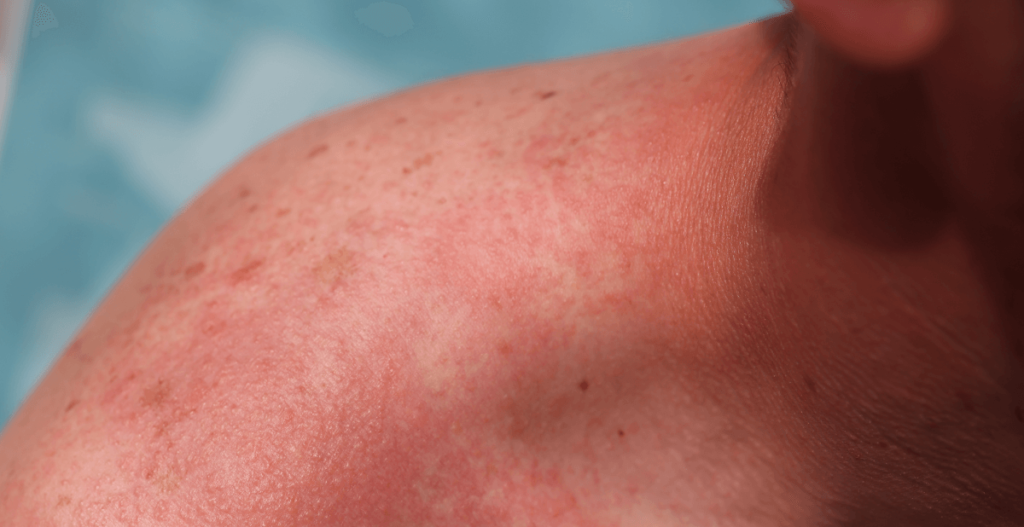As the primary heat rays of sunshine arrive, the whole lot calls us outdoors—a stroll, a spontaneous picnic, or just that blissful second of closing your eyes and absorbing the solar. However what occurs when that peaceable second turns into an itchy, pink rash?
You may be coping with a solar allergy, a pores and skin response that’s extra widespread than you may assume. The truth is, it’s estimated that as much as 20% of individuals in the USA expertise it—particularly initially of spring and summer season. And though they often aren’t severe, they are often uncomfortable.
We spoke with Alessandro De Luca, Medical Affairs Specialist at ISDIN, to higher perceive this phenomenon and the right way to handle it. At this time, we’re diving into what solar allergy actually is, who’s extra prone to get it, and the right way to assist stop it—with out lacking out on the sunshine.
Let’s get began.
What’s a solar allergy?
As quickly as we sit down with Alessandro, he needs to make clear one factor: “Solar allergy is definitely an umbrella time period for a couple of totally different circumstances. However, when folks say solar allergy or solar rash, they’re often referring to a typical response referred to as polymorphous gentle eruption, or PLE.”
So, what’s the distinction? “PLE exhibits up as a rash on areas uncovered to daylight—usually throughout the first few occasions you’re out within the solar, like early spring or summer season. It tends to happen extra usually in folks with lighter pores and skin tones,” he explains.
Alessandro additionally brings up one other situation referred to as photo voltaic urticaria. “That is persistent photosensitivity to daylight that causes hives. It might probably have an effect on any pores and skin tone and seem wherever on the physique. It’s a lot much less widespread than PLE. However since they’re two various things, each might present up on the identical time.”
To sum issues up, the time period solar allergy is a broad one. And the commonest kind of solar response is definitely a particular situation referred to as polymorphous gentle eruption—that’s what we’ll concentrate on on this article.
What’s periodic solar rash (polymorphous gentle eruption)?
PLE is a rash triggered by photo voltaic radiation in people who find themselves delicate to daylight. These itchy, pink, infected bumps or patches usually pop up on the chest, forearms, decrease legs, or toes a couple of hours to days after your first sunny outing of the season.
“Most frequently, it exhibits up in spring or on the primary heat days of the 12 months, when your pores and skin hasn’t had time to regulate,” says Alessandro. It’s not precisely the sunny welcome you’d hoped for… However the excellent news? It often goes away by itself inside per week or two and doesn’t go away any everlasting marks.
What does solar rash seem like?
Folks often discover small pink bumps or patches that itch, burn, or sting. What’s attention-grabbing? It usually impacts areas that have been coated throughout winter, like your chest, arms, or the backs of your fingers.
“Many individuals don’t understand it’s a solar response as a result of it doesn’t look or really feel like a typical sunburn,” Alessandro explains.

What causes a solar allergy?
Because the phrase solar allergy covers loads of issues, there are a selection of causes. Some folks have a kind of solar allergy that’s handed down via genetics. Others have particular triggers — resembling sure drugs and even contact with vegetation. And most of the causes behind solar reactions are nonetheless being studied.
Frequent solar rash or PLE is considered attributable to your physique’s immune response to daylight after a season spent largely indoors. Consider it as your physique saying, “Whoa, that’s loads of solar!” after being out of form.
Who’s extra prone to expertise a solar allergy?
Solar allergy symptoms can have an effect on anybody, irrespective of your age, gender, or pores and skin tone. However there is a sample.
PLE makes up about 70% of all pores and skin reactions from the solar. It tends to have an effect on younger ladies with lighter pores and skin tones who dwell in locations with large seasonal shifts—the place winter and summer season really feel worlds aside. Alessandro elaborates, “Any such response usually begins in adolescence or your 20s, particularly in ladies. And as soon as it seems, it might come again annually.”
“The attention-grabbing factor,” he provides, “is that your pores and skin will be ‘skilled.’ As solar publicity will increase over the season, the response often will get milder—or could cease occurring altogether.”

What will increase your possibilities?
Sure components can make you extra susceptible to solar rash:
- Having a gentle pores and skin tone that burns simply
- Residing in areas with lengthy winters or low daylight
- A household historical past of solar reactions
- And sure… being feminine, based on medical research
How will you assist deal with a solar allergy?
First issues first, get your dermatologist concerned. “Do not forget that solar allergy is an umbrella time period, and your dermatologist will have the ability to greatest diagnose the kind and advise remedy,” advises Alessandro.
Relating to PLE or periodic solar rash, it’s greatest to get your first rays progressively to assist decrease signs. “One of the widespread errors is leaping again into full solar publicity after months with out it,” Alessandro shares. “Identical to your physique must ease into train after a break, your pores and skin wants time to regulate.”
These two habits could make a giant distinction:
- Begin with quick intervals of solar publicity, throughout lower-intensity hours (earlier than 11 a.m. or after 5 p.m.). This helps your pores and skin progressively adapt to daylight with out overreacting.
- Use sunscreen on daily basis, even on cloudy days or while you’re solely open air briefly. Select an all-mineral components with broad spectrum SPF 50+ safety. Bear in mind to reapply at the very least each two hours.

Simply the FAQs
Is a solar allergy severe?
More often than not, periodic solar rash (or PLE) clears up by itself inside a couple of days. However that doesn’t imply you must ignore it. At all times seek the advice of your dermatologist in the event you discover one thing uncommon or if it occurs 12 months after 12 months.
Right here’s when you must search instant medical care:
- Your rash is spreading rapidly or already widespread
- Your rash is painful
- You even have a fever
Is a solar allergy an autoimmune illness?
It relies upon, since there are numerous sorts of solar allergy symptoms. Within the case of PLE, the commonest type of solar allergy, sure—it’s thought of a delicate autoimmune response. Immune cells in folks with PLE react to UV rays, triggering a protection response within the pores and skin.
Now you realize a bit extra about your pores and skin and the commonest solar allergy: polymorphous gentle eruption. And bear in mind, the excellent news is that it’s often momentary and manageable at house.
With the correct safety, a little bit of endurance, and loads of care, you possibly can preserve having fun with the sunshine stress-free. Take your time—you’ve acquired all summer season!
References:
1 Frcpc, S. a. a. M. (n.d.). Polymorphous Mild Eruption: Background, Pathophysiology, Etiology. https://emedicine.medscape.com/article/1119686-overview
2 Gruber-Wackernagel, A., Schug, T., Graier, T., Legat, F. J., Rinner, H., Hofer, A., Quehenberger, F., & Wolf, P. (2021). Lengthy-Time period Course of Polymorphic Mild Eruption: A Registry Evaluation. Frontiers in Drugs, 8. https://doi.org/10.3389/fmed.2021.694281
3 Harris, B. W. (2022, September 27). Photo voltaic Urticaria. StatPearls – NCBI Bookshelf. https://www.ncbi.nlm.nih.gov/books/NBK441986/
4 Oakley, A. M. (2022, August 8). Polymorphic Mild Eruption. StatPearls – NCBI Bookshelf. https://www.ncbi.nlm.nih.gov/books/NBK430886/



